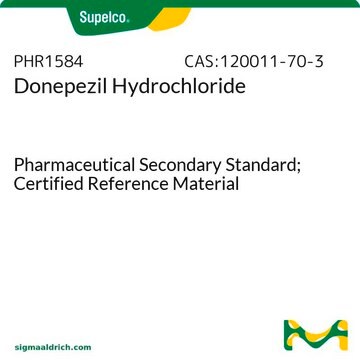S0929
Scopolamine hydrobromide
meets USP testing specifications
Synonyme(s) :
(−)-Scopolamine hydrobromide trihydrate, Hyoscine hydrobromide, Scopine tropate
About This Item
Produits recommandés
Agence
USP/NF
meets USP testing specifications
Niveau de qualité
Pf
195-199 °C (dry matter) (lit.)
Application(s)
pharmaceutical (small molecule)
Chaîne SMILES
O.O.O.Br.CN1[C@@H]2C[C@H](C[C@H]1[C@@H]3O[C@H]23)OC(=O)[C@H](CO)c4ccccc4
InChI
1S/C17H21NO4.BrH.3H2O/c1-18-13-7-11(8-14(18)16-15(13)22-16)21-17(20)12(9-19)10-5-3-2-4-6-10;;;;/h2-6,11-16,19H,7-9H2,1H3;1H;3*1H2/t11-,12-,13-,14+,15-,16+;;;;/m1..../s1
Clé InChI
LACQPOBCQQPVIT-SEYKEWMNSA-N
Informations sur le gène
human ... CHRM1(1128)
Vous recherchez des produits similaires ? Visite Guide de comparaison des produits
Application
- to reverse the cardiac effects of physostigmine in rabbit heart
- to study its effect on acoustic startle reflex (gap-PPI){148)
- to study it′s in vitro antiviral, antibacterial, and antifungal activities and cytotoxicity
- to study its effect on conditioning of lever pressing
Actions biochimiques/physiologiques
Mention d'avertissement
Danger
Mentions de danger
Conseils de prudence
Classification des risques
Acute Tox. 1 Dermal - Acute Tox. 2 Inhalation - Acute Tox. 2 Oral
Code de la classe de stockage
6.1A - Combustible acute toxic Cat. 1 and 2 / very toxic hazardous materials
Classe de danger pour l'eau (WGK)
WGK 1
Point d'éclair (°F)
Not applicable
Point d'éclair (°C)
Not applicable
Équipement de protection individuelle
Eyeshields, Faceshields, Gloves, type P3 (EN 143) respirator cartridges
Choose from one of the most recent versions:
Certificats d'analyse (COA)
Don't see the Right Version?
If you require a particular version, you can look up a specific certificate by the Lot or Batch number.
Déjà en possession de ce produit ?
Retrouvez la documentation relative aux produits que vous avez récemment achetés dans la Bibliothèque de documents.
Les clients ont également consulté
Notre équipe de scientifiques dispose d'une expérience dans tous les secteurs de la recherche, notamment en sciences de la vie, science des matériaux, synthèse chimique, chromatographie, analyse et dans de nombreux autres domaines..
Contacter notre Service technique











